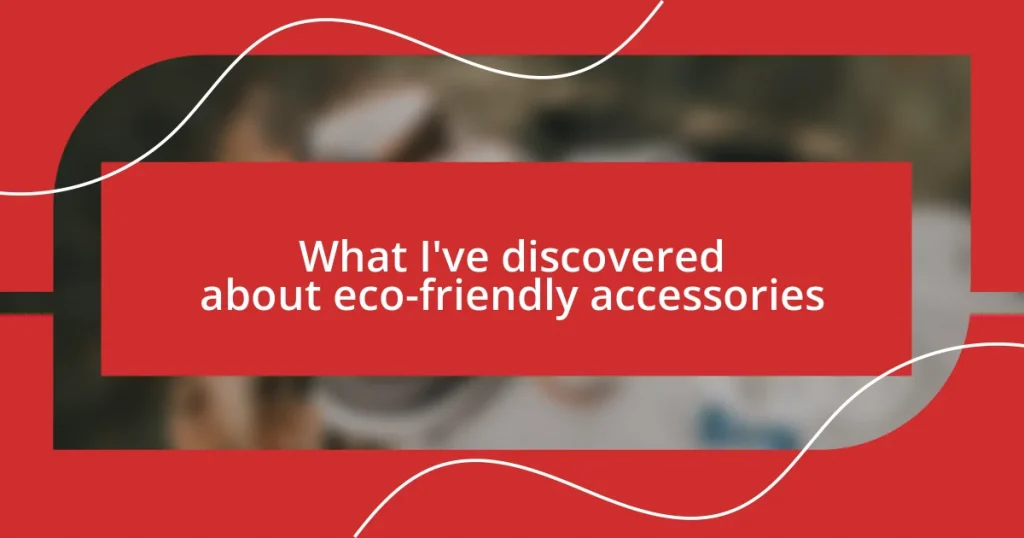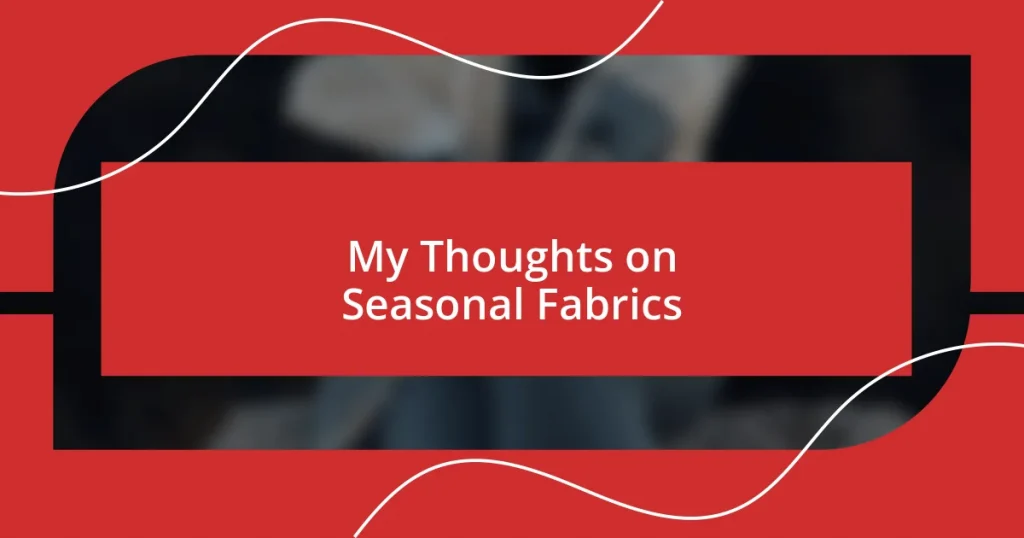Key takeaways:
- Eco-friendly accessories offer sustainable options that reflect personal values and commitment to reducing environmental impact, utilizing materials like recycled plastic and vegan leather.
- Choosing eco-friendly products fosters community support and encourages mindful consumption, leading to a greater appreciation for quality over quantity.
- The future of eco-friendly accessories is promising, with innovations such as recycled ocean plastics and 3D printing enhancing sustainability and personalization while increasing demand for transparency in sourcing practices.
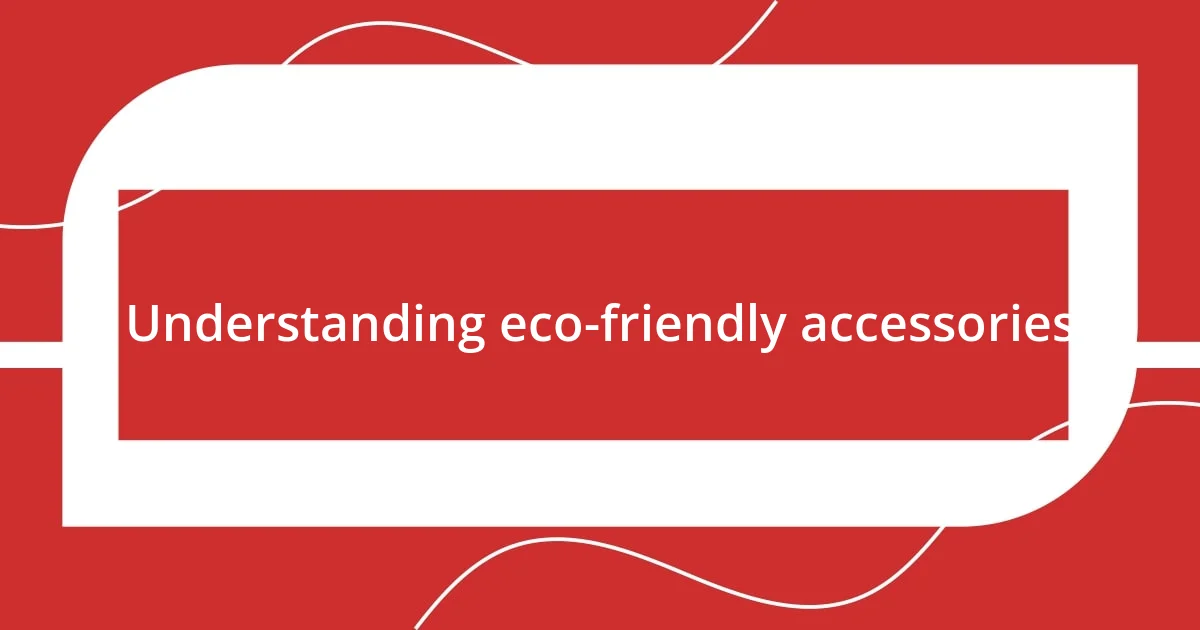
Understanding eco-friendly accessories
When I first started exploring eco-friendly accessories, I was surprised by how many options were available. From bags made of recycled materials to jewelry crafted from ethically sourced stones, these products not only help the planet but can also reflect personal style. Have you ever considered how your choice of accessories can make a statement about your values?
One of my favorites is a necklace I bought that was made from upcycled ocean plastic. Every time I wear it, I can’t help but feel a deep connection to the ocean and a sense of pride in supporting sustainable practices. It’s not just an accessory; it’s a conversation starter about the importance of reducing plastic waste. How often do we get to wear our values so visibly?
Understanding eco-friendly accessories is about recognizing the impact our choices have on the environment. These products often prioritize sustainability in every aspect, from materials to production methods. It’s a different mindset, one that encourages us to be more thoughtful about what we wear and how that affects the world around us.
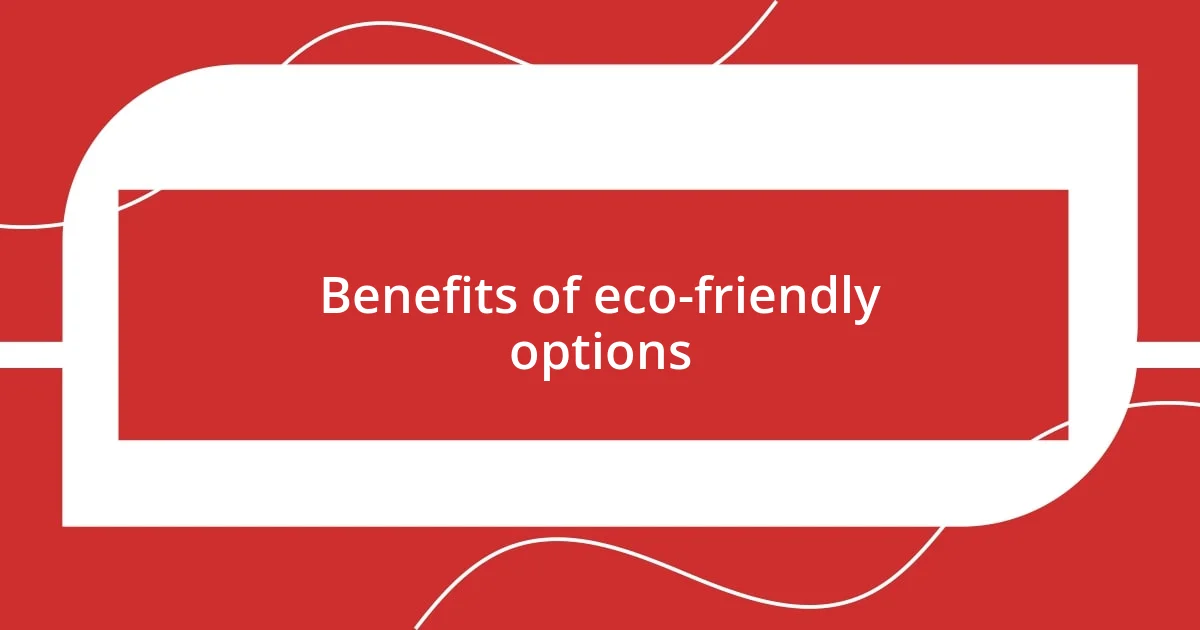
Benefits of eco-friendly options
Eco-friendly options offer numerous benefits that extend beyond just environmental impact. For instance, choosing accessories made from sustainable materials often means they’re also more durable. I remember purchasing a bamboo watch that not only looks chic but has outlasted every leather watch I’ve owned. The craftsmanship and quality are undeniably superior, making it a smart investment.
Additionally, supporting eco-friendly brands can foster a sense of community and connection. Whenever I shop from local artisans who use recycled materials, I feel like I’m contributing to a movement that values craftsmanship over mass production. It’s rewarding to know my purchases support small businesses that prioritize ethical practices and promote a healthier planet.
Moreover, eco-friendly choices often encourage mindfulness in our consumption habits. By consciously selecting accessories that promote sustainability, I’ve developed a greater appreciation for quality over quantity. Each piece becomes significant, a meaningful addition to my collection rather than just another item to wear. This shift in mindset enriches my relationship with fashion and personal expression.
| Eco-Friendly Accessories | Traditional Accessories |
|---|---|
| Durability | Often less durable, prone to wear and tear |
| Impact on community | Supports local artisans and ethical brands |
| Mindful Consumption | Often promotes fast fashion and overconsumption |
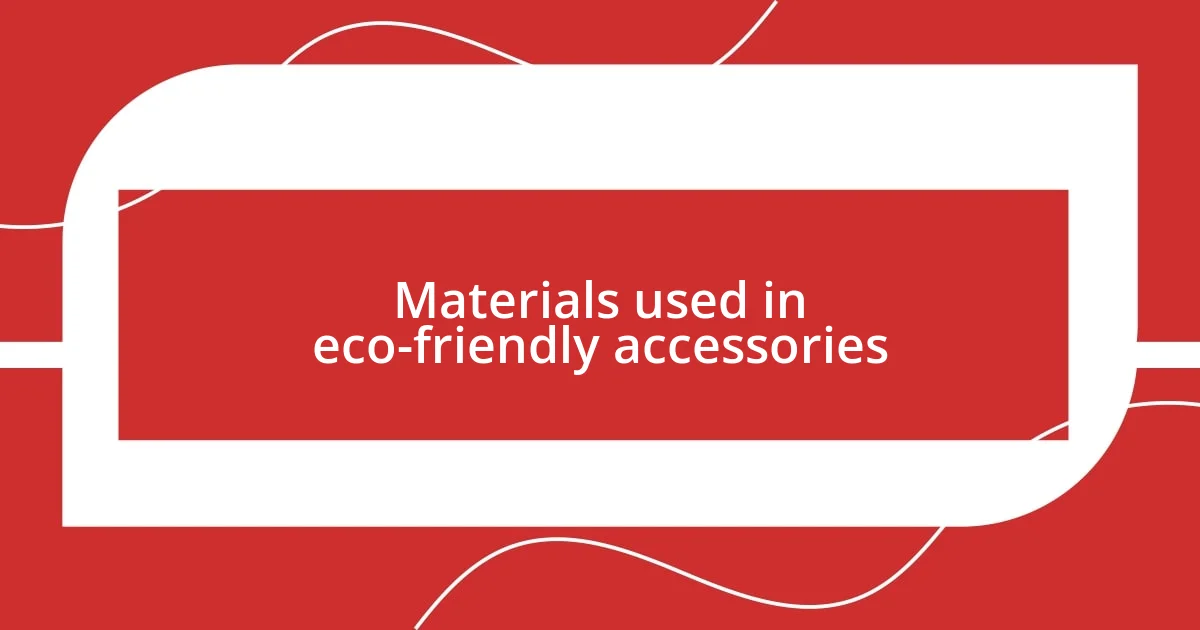
Materials used in eco-friendly accessories
One of the most fascinating aspects of eco-friendly accessories is the diverse range of materials being used. I’ve come across items made from organic cotton, reclaimed wood, and even innovative fabrics derived from pineapple leaves known as Piñatex. There’s something incredibly satisfying about wearing a bracelet crafted from recycled glass bottles; not only does it look unique, but knowing its backstory adds a personal touch to my style.
Here’s a quick list of materials commonly found in eco-friendly accessories:
- Recycled Plastic: Reduces waste and can be transformed into jewelry or bags.
- Bamboo: A fast-growing, sustainable resource that’s both lightweight and durable.
- Cork: Harvested from the bark of cork trees, it’s biodegradable and water-resistant.
- Vegan Leather: Made from innovative materials like apple peels or mushrooms, offering a cruelty-free alternative to traditional leather.
- Natural Dyes: Used to color fabrics in a way that avoids harmful chemicals, enhancing the sustainability of the accessory.
Every time I choose an accessory made from these materials, I feel connected to the broader movement toward sustainability. It’s a reminder that small choices can lead to significant environmental benefits.
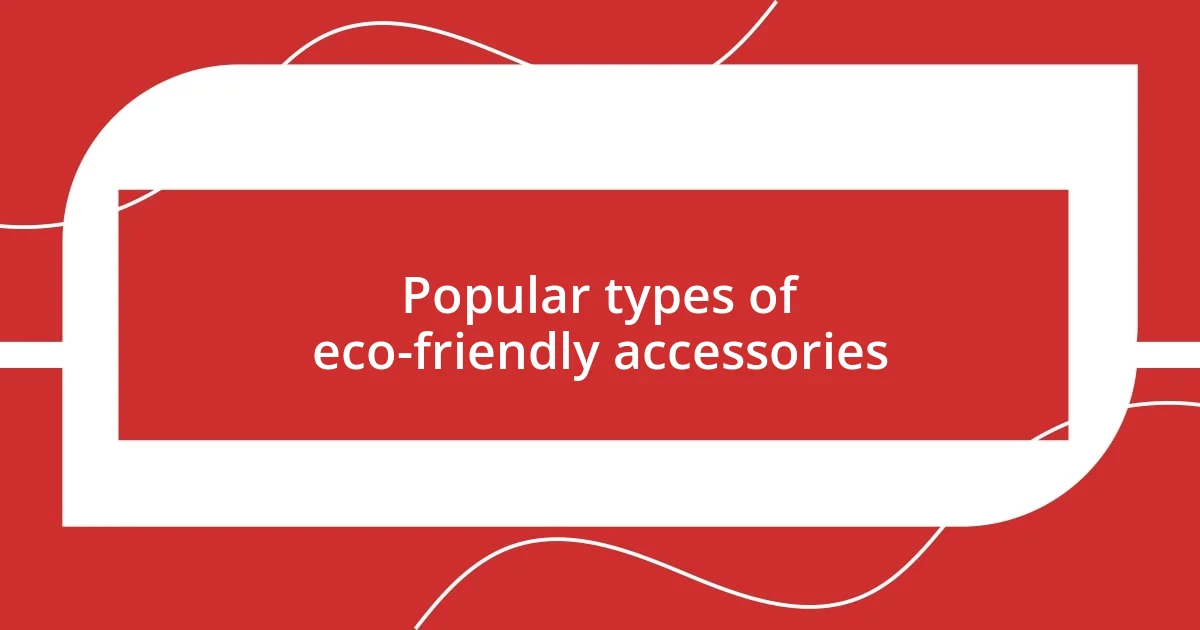
Popular types of eco-friendly accessories
When it comes to popular types of eco-friendly accessories, I’ve noticed that reusable bags have soared in popularity. I remember the first time I swapped my plastic shopping bag for a stylish tote made from recycled material. Not only did it feel good to make a responsible choice, but I found myself constantly complimented on its unique design. It’s incredible how something so simple can make such an impression while minimizing plastic use.
Jewelry made from sustainable materials also stands out. Recently, I stumbled upon a pair of earrings crafted from repurposed silver. They not only had an elegant, artisanal touch but also came with a story that resonated with my values. This connection transforms a piece into more than just an accessory—it becomes a conversation starter, making me wonder: how can we use accessories to inspire change and spark dialogue?
Lastly, eco-friendly watches have become a personal favorite of mine. The craftsmanship of wooden watches, in particular, never ceases to amaze me. I recall once receiving a bamboo watch as a gift; its warmth and natural hues added a touch of earthiness to my outfits. Every glance at it reminded me of my commitment to sustainability, serving both as a stylish piece and a daily motivator. Isn’t it refreshing to wear something that aligns with your values?
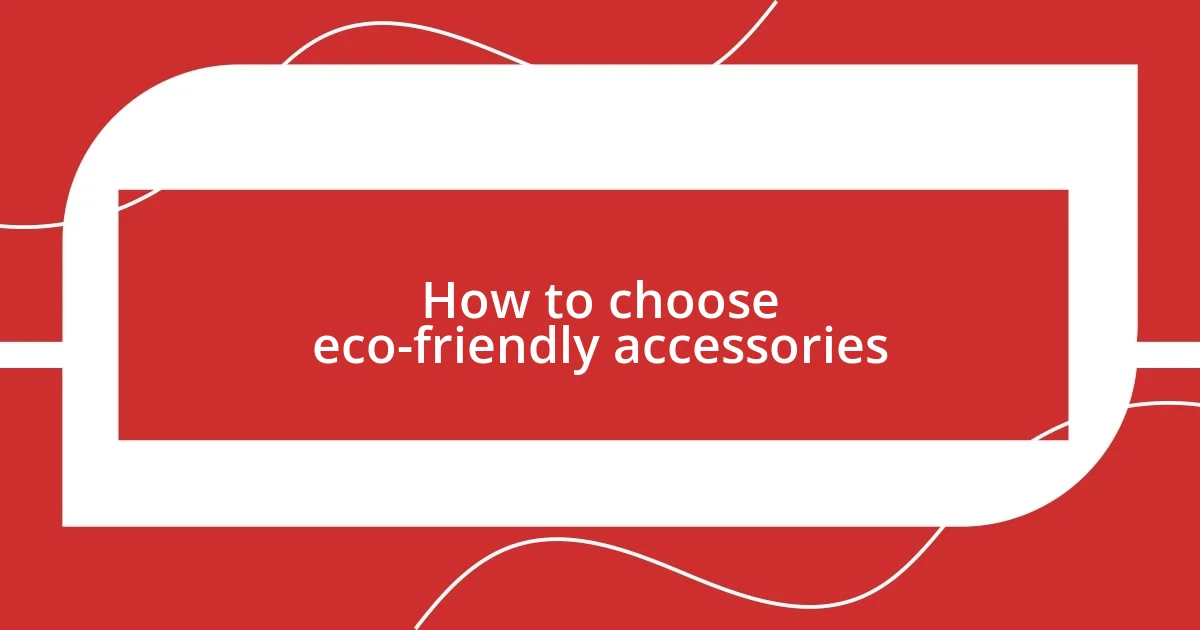
How to choose eco-friendly accessories
Choosing eco-friendly accessories can be a rewarding experience that aligns with my values. First, I always check the brand’s mission and transparency about their sourcing practices. For instance, I came across a company that openly shares its supply chain, and knowing the positive impact of my purchase feels like a small victory with every accessory I wear. Why settle for less when I can directly support businesses committed to sustainability?
Another important factor is longevity. I recall investing in a pair of biodegradable sunglasses that are not only stylish but also durable. The thought of them breaking down naturally when I’m done with them is much more appealing than tossing a cheap plastic pair in the trash. Isn’t it empowering to know that the accessories we choose can leave a light footprint on the planet?
Lastly, I consider the impact of color and design. I once chose a vibrant, handwoven bracelet made by artisans in a fair trade community. It’s beautiful, and every time I wear it, I feel connected to the stories of the makers behind it. Doesn’t wearing something meaningful add a deeper dimension to fashion? By focusing on the artisans’ stories and the product’s purpose, I find myself wearing pieces that are not just accessories, but expressions of a mindful lifestyle.
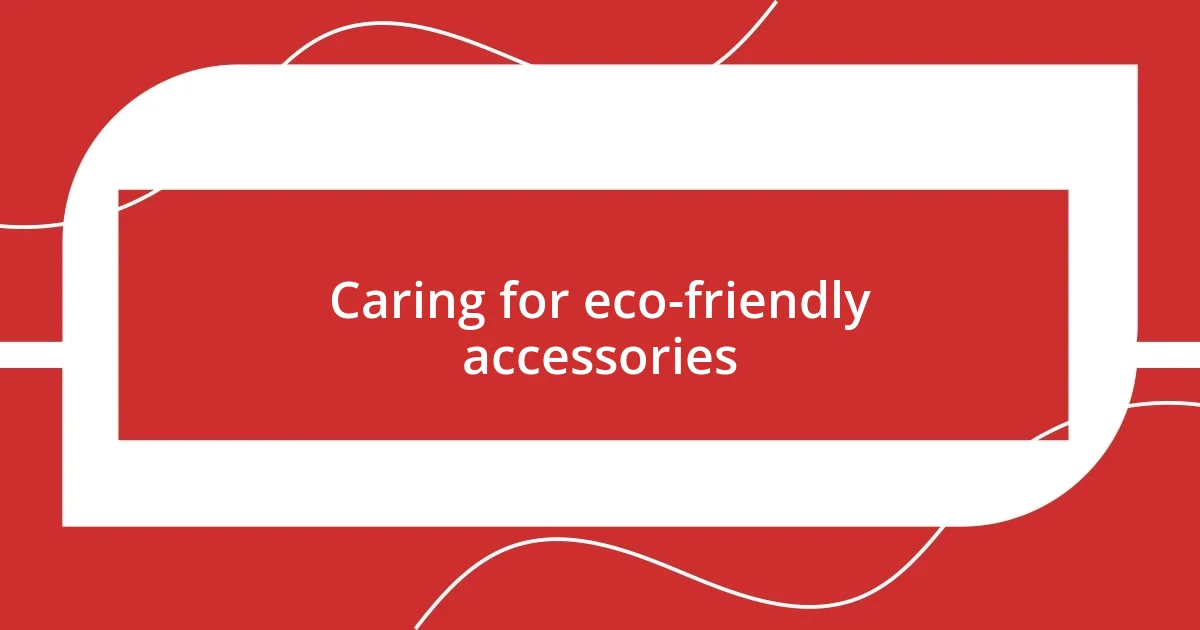
Caring for eco-friendly accessories
Caring for eco-friendly accessories takes a bit of thoughtfulness and TLC. I remember the first time I accidentally tossed my beloved hemp backpack into the washing machine on a hot cycle. I was devastated when it came out shrunk and stiff! Now, I always hand wash my eco-friendly fabrics with gentle soap and cold water, ensuring they stay vibrant and maintain their shape. How we treat these items reflects our commitment to sustainability, doesn’t it?
I’ve also learned that storage matters. A while back, I stacked my organic cotton scarves in a drawer, only to discover they became wrinkled and stained over time. Now, I drape them over hangers, and it not only prevents damage but also allows me to appreciate their beauty daily. Have you ever experienced the joy of seeing your accessories on display? It transforms how I engage with them; they feel special and worthy of care.
Lastly, proper repair methods can extend the life of eco-friendly accessories significantly. I once had a wooden bracelet that lost a bead during a hike. Instead of discarding it, I learned how to reattach the bead and in the process, took pride in fixing something I loved. Isn’t it rewarding to breathe new life into items by mending them rather than replacing them? By investing time into repairs, we can cultivate an emotional connection to our accessories while also reducing waste.
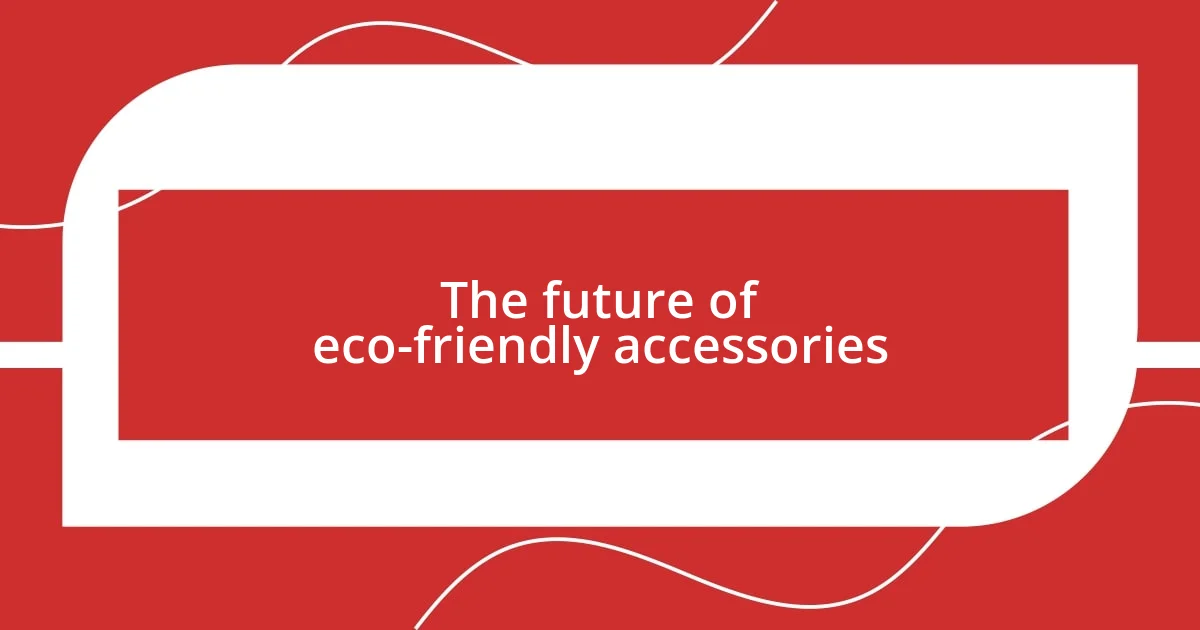
The future of eco-friendly accessories
The future of eco-friendly accessories is undoubtedly bright, and I find this evolution fascinating. Recently, I discovered a line of accessories made from recycled ocean plastics, and it struck me just how innovative this industry has become. Seeing materials that once harmed our oceans transformed into beautiful products feels like a symbolic response to environmental challenges, doesn’t it?
I often think about how technology will continue to shape this space. For example, I heard about brands utilizing 3D printing to create customized accessories, reducing waste in the process. I can only imagine the excitement of wearing a piece that’s tailored just for me, reflecting not only my style but also a commitment to sustainability. How incredible is it that we can wear our values?
Moreover, I believe the growing demand for transparency will play a crucial role. As I browse for new pieces, I increasingly appreciate when brands showcase their sustainability efforts. There’s something profoundly empowering about supporting companies that openly embrace ethical practices. Have you ever felt that thrill when discovering an accessory that embodies both style and responsibility? It truly deepens the connection I feel to what I wear, making each piece a conversation starter about the positive change we can all contribute to.










